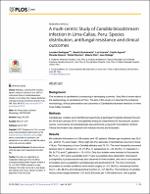A multi-centric Study of Candida bloodstream infection in Lima-Callao, Peru: species distribution, antifungal resistance and clinical outcomes.
Related Resource(s)
https://journals.plos.org/plosone/article?id=10.1371/journal.pone.0175172Date
2017-04Author(s)
Rodriguez, Lourdes
Bustamante, Beatriz
Huaroto, Luz
Agurto, Cecilia
Illescas, Ricardo
Ramirez, Rafael
Díaz, Alberto
Hidalgo, José
Metadata
Show full item recordAbstract
La incidencia de candidemia está incrementada en países en desarrollo. Muy poco es conocido sobre la epidemiología de la candidemia en Perú. El objetivo de este estudio es describir la incidencia, microbiología, presentación clínica y el desenlace de las infecciones del torrente sanguíneo por cándida, en los hospitales Guillermo Almenara Irigoyen, Dos de Mayo y Alberto Sabogal, entre noviembre 2013 y enero 2015. La información fue obtenida de las historias clínicas y evaluada. Se encontró una proporción muy alta de especies de Candida no albicans, a pesar de esto, la disminuída susceptibilidad/resistencia al fluconazol fue sólo del 13.3% y no se observó en otros tratamientos antifungicos. Sin embargo, la incidencia de mortalidad por candidemia fue alta comparada con otros estudios internacionales. Es posible que el retrazo en el inicio del tratmiento antifúngico contribuyera al alto nivel de mortalidad a pesar de la baja resistencia antifúngica. The incidence of candidemia is increasing in developing countries. Very little is known about
the epidemiology of candidemia in Peru. The aim of this study is to describe the incidence,
microbiology, clinical presentation and outcomes of Candida bloodstream infections in three
Lima-Callao hospitals. Methods: Candida spp. isolates were identified prospectively at participant hospitals between November 2013 and January 2015. Susceptibility testing for amphotericin B, fluconazole, posaconazole, voriconazole and anidulafungin was performed using broth microdilution method.
Clinical information was obtained from medical records and evaluated.
Results: We collected information on 158 isolates and 157 patients. Median age of patients was 55.0
yrs., and 64.1% were males. Thirty-eight (24.2%) episodes of candidemia occurred in those
<18 yrs. The frequency of non-Candida albicans was 72.1%. The most frequently recovered
species were C. albicans (n = 44, 27.8%), C. parapsilosis (n = 40, 25.3%), C. tropicalis (n =
39, 24.7%) and C. glabrata (n = 15, 9.5%). Only four isolates were resistant to fluconazole,
86.7% (n = 137) were susceptible and 17 were susceptible-dose dependent. Decreased
susceptibility to posaconazole was also observed in three isolates, and one to voriconazole.
All isolates were susceptible to anidulafungin and amphotericin B. The most commonly
associated co-morbid conditions were recent surgery (n = 61, 38.9%), mechanical ventilation (n = 60, 38.2%) and total parenteral nutrition (n = 57, 36.3%). The incidence of candidemia by center ranged between 1.01 and 2.63 cases per 1,000 admissions, with a global incidence of 2.04. Only 28.1% of cases received treatment within 72 hrs. of diagnosis. Overall, the 30-day survival was 60.4% (treated subjects, 67.4%; not-treated patients, 50.9%).
Conclusions: We found a very high proportion of non-albicans Candida species. Despite this, the
decreased susceptibility/resistance to fluconazole was only 13.3% and not seen in the
other antifungals. Overall, the incidence of candidemia mortality was high when compared to other international studies. It is possible, that the delay in initiating antifungal
treatment contributed to the elevated mortality rate, in spite of low antifungal resistance.
Notes
El Consejo Editorial es un equipo de expertos en el campo de la revista.
Collections
- Artículos científicos [890]






